Planning team sprints, writing and reading user stories, building out product backlogs, assisting with prototyping or coding here and there — these are a few of the many duties of a typical product manager.
“One thing that makes the role so interesting and challenging is that you often don’t know what you’ll need to do until you’re doing it,” Matt LeMay, a product-management veteran and co-founder of information-services studio Sudden Compass, told Built In.
But for all the moving parts and the role’s unique hybrid of the facilitative, technical and creative, the job boils down to value. A product manager’s job is to “facilitate an exchange of value between a company and its customers,” writes Melissa Perri in Escaping the Build Trap.
16 Recommended Product Management Books
- Escaping the Build Trap by Melissa Perri
- Product Roadmaps Relaunched by C. Todd Lombardo, Bruce McCarthy, Evan Ryan and Michael Connors
- Testing Business Ideas by Alexander Osterwalder and David J. Bland
- The Art of Action by Stephen Bungay
- Unlearn by Barry O’Reilly
- Product Management in Practice by Matt LeMay
- The Five Dysfunctions of a Team by Patrick Lencioni
- Pencil Me In by Christina Wodtke
- Customers Included by Mark Hurst and Phil Terry
- The Customer-Driven Culture by Travis Lowdermilk and Monty Hammontree
- The Customer-Driven Playbook by Travis Lowdermilk and Jessica Rich
- Product Leadership by Martin Eriksson, Nate Walkingshaw and Richard Banfield
- Super Thinking by Gabriel Weinberg and Lauren McCann
- The ONE Thing by Gary W. Keller and Jay Papasan
- Play Bigger by Al Ramadan, Dave Peterson, Christopher Lochhead and Kevin Maney
- Good to Great by Jim Collins
“It’s such a simple idea, but such a powerful way of framing the job,” said LeMay, who cites Escaping as one of the best product management books available.
Indeed, the very idea of distillation — thoughtful prioritization, measuring outcomes rather than sheer number of product or feature builds, generally seeing the big-picture forest for all the administrative trees — emerged repeatedly in our conversation with three experts about must-read product management books.
We spoke with LeMay, Perri and Richard Banfield — all authors of books about product management — to get their insights and recommendations for other books to check out.
- Melissa Perri: founder and CEO of Produx Labs, Harvard Business School senior lecturer, author or Escaping the Build Trap.
- Matt LeMay: co-founder and partner at Sudden Compass, author of Product Management in Practice
- Richard Banfield: VP of design transformation at InVision, co-author of Product Leadership
MELISSA PERRI
 Escaping the Build Trap: How Effective Product Management Creates Real Value by Melissa Perri
Escaping the Build Trap: How Effective Product Management Creates Real Value by Melissa Perri
There were a lot of books on product management from a day-to-day perspective, but I kept getting questions about how product works holistically. What is product management? How does it fit into a company? What do leaders do? How is that different than what product managers do on a team? What do organizations that do product management well look like? That’s what I wanted to write about in my book.
The “build trap” is a scary place companies get into when they focus more on how many products and features they’re shipping, and they stop thinking about why. Why are we shipping this feature? Why are we building this feature and what business value and customer value does that actually produce? And you can see it in any company that starts to scale or is scaled.
Small startups have to be focused. They can only do one thing because there are so many constraints on people and money. You have to figure out, what’s the most important thing to do?
But growth-stage companies are scaling quickly and taking on more money, so they have a lot more runway. Then it becomes a race to achieve that business value faster, usually to pay investors. You start to see companies spread themselves thin and not focus on what’s really going to drive value.
Large companies are of course the biggest culprits. They have so many people and so much money that they can afford to spread people thin across multiple initiatives, and it takes so long to develop and ship work that they don’t realize they’re not producing value until it’s too late.
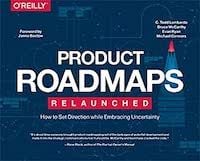 Product Roadmaps Relaunched: How to Set Direction While Embracing Uncertainty by C. Todd Lombardo, Bruce McCarthy, Evan Ryan and Michael Connors
Product Roadmaps Relaunched: How to Set Direction While Embracing Uncertainty by C. Todd Lombardo, Bruce McCarthy, Evan Ryan and Michael Connors
A lot of product managers struggle with roadmaps; this is a great book for that. It shows how a lot of different companies can do roadmaps, and how to make a great roadmap. It dissects it into manageable pieces. The authors explain the concept behind a roadmap, which is a communication tool, not a Gantt chart. They show you lots of examples and help you build it out. That’s great for product managers.
 Testing Business Ideas: A Field Guide for Rapid Experimentation by Alexander Osterwalder and David J. Bland
Testing Business Ideas: A Field Guide for Rapid Experimentation by Alexander Osterwalder and David J. Bland
It’s part of the Strategyzer collection — a great book for product managers to understand how to test different ideas, reduce risk and make sure you’re going in the right direction. David breaks it down into different types of risks, [shows] where the uncertainty lies and then walks you through what types of experiments you can run in a B2B or B2C setting.
When I started out in this, doing experimentation back in 2010, that’s when the Lean Startup was all the rage. And a lot of people read about experimentation there, but then they misinterpreted it and used a lot of B2C tactics in their companies, so it scared all the CEOs, especially in B2B. It failed really miserably and people got really uncomfortable with experimentation.
David’s book is a great follow-up to that. It’s like, No, you shouldn’t just be blindly putting buttons to nowhere. Experimentation is about reducing risk. He provides a slew of different types of experiments you could do to reduce risk, and make sure that you’re actually building something that’s valuable.
Product managers build business ideas. They’re part of a product; it just might be a feature set that’s part of a much bigger thing, but you can use the same concepts.
 The Art of Action: How Leaders Close the Gaps Between Plans, Actions and Results by Stephen Bungay
The Art of Action: How Leaders Close the Gaps Between Plans, Actions and Results by Stephen Bungay
I recommend this a lot to both leaders and product managers. It’s a little less practical, or specifically about product management, but it tells you how strategy should be created and deployed. It also tells you about a lot of things you may observe in your company and understand why they’re broken.
For instance, I always hear product managers complain that their leaders are diving into the weeds, micromanaging them, going through their Jira tickets they shouldn’t be in.
What he really explains in this book is that when information is poorly communicated to leaders, they’re going to search for information that’s usually too deep in the weeds. So it’s more on the product managers at that point for not communicating at the right level, to the right person, the information that they need to know. So it gives you insights into what leaders care about, how a strategy is set, and it can help you fill in the gaps if you don’t have a very clear strategy in your company. And it also explains some bad practices that you do see in companies that frustrate a lot of product managers.
 Unlearn: Let Go of Past Success to Achieve Extraordinary Results by Barry O’Reilly
Unlearn: Let Go of Past Success to Achieve Extraordinary Results by Barry O’Reilly
It’s about unlearning past behaviors that led to success so that you can move forward. This is especially true in the context of trying new things in innovation and technology. It talks about how we have to be reflective and understand that the way that we did things in the past and the way that we got here are not necessarily what we need to take with us going forward. How do you unlearn those past bad behaviors and start to move forward.
We see a lot of companies taking subject matter experts or people from different parts of the business and throwing them into the product manager role. And then the companies themselves are trying to adopt new technologies and rapid iterations and agile and all that wonderful stuff. And you have to learn a lot of the old ways of doing work that made you successful in those other roles in order to be successful in this new context.
So I’d recommend it for any product manager in a large company who’s attempting this type of transformation work, or moving to this new way for product management.
MATT LEMAY
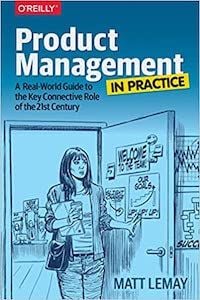 Product Management in Practice: A Real-World Guide to the Key Connective Role of the 21st Century by Matt LeMay
Product Management in Practice: A Real-World Guide to the Key Connective Role of the 21st Century by Matt LeMay
Product management is often framed as a visionary role, where you’re creating roadmaps and doing lots of strategic work — beginning-to-end customer-need discovery, testing the customer need and then launching something that meets the customer need and iterating from there.
That’s part of product management, but a lot of day-to-day work is much less glamorous, less strategic — more facilitative than visionary. The analogy I use in the book is that it’s less like an expertly played game of chess and more like a hundred simultaneous annoying games of checkers.
So I wanted to write something that both provided tactical guidance for doing those less glamorous parts of the job and also reinforce to working product managers that, if you find yourself doing a lot of those less glamorous things, that doesn’t mean you’re a bad product manager.
I hoped to give some guidance as to the types of day-to-day challenges they might encounter — especially around communication — but also a sense that, if those are the challenges they’re facing, that doesn’t mean that they’re not doing the real work of product management. That is, in many cases, the real work of product management.
It was really important for me to interview working product managers who are not product-management thought leaders — the kind of rank-and-file product managers who do this day in, day out. I started interviews by asking, “What’s one story from your work that you wish somebody could have told you when you started out?”
Almost every story I heard was about executive communication. I expected more [answers] to be about roadmaps, prioritization, product strategy and user interviews. But almost all were about executive communication and stakeholder management — how to communicate openly and transparently with people who have direct organizational authority.
 The Five Dysfunctions of a Team by Patrick Lencioni
The Five Dysfunctions of a Team by Patrick Lencioni
This was one of the first business books I read as a product manager and it really changed the way I see my role. It’s about leadership and team dynamics, but I think there’s a sneaky, powerful lesson in this book about storytelling. It’s written in the format of a leadership fable, a fictionalized narrative. My biggest takeaways were not just specific things about how teams function and how they can work together, but also understanding how powerful and important it is to tell good stories. You can show people a million graphs, charts and models, but it’s the stories that they’re going to remember. And Lencioni is such a great writer and such a great storyteller.
Lencioni’s The Advantage, which is about organizational health, was another huge one for me. That’s written more as a traditional business book. But his way of seeing and writing is so compelling and so generous. Again, not only understanding team dynamics and having concrete examples of those dynamics, but also understanding how telling the stories of those team dynamics is the first step toward understanding and addressing them. Hugely important.
 Pencil Me In: the Business Drawing Book for People Who Can’t Draw by Christina Wodtke
Pencil Me In: the Business Drawing Book for People Who Can’t Draw by Christina Wodtke
A short, fun book about visual communication. This one is particularly important to me because I’m not a visual communicator by nature; I’m a words person. A lesson I’ve learned the hard way as a product manager is that you need to be able to visually communicate your work, especially when you’re communicating to a broad audience or an executive audience.
I see this a lot with teams I coach, where people get frustrated because they feel that other people, executives in particular, aren’t grasping their ideas. But they haven’t presented those ideas in a concise visual way. In a lot of cases, people need to see something to really understand it.
Narrative storytelling is really important, but some people are more receptive to visual. As a product manager. you have to be really fluent in both approaches to communication. There’s information about creating empathy maps, drawing interfaces, creating a visual library — tactical things like that.
But there are also more general things, like how to draw expressive faces, how to draw better stick figures, how to use shapes — all so you can communicate better. So it’s not just about specific modes of visual communication or specific artifacts of visual communication. It’s about the entire universe of visual communication, which is super helpful.
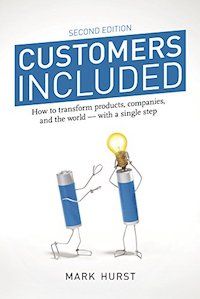 Customers Included: How to Transform Products, Companies, and the World — With a Single Step by Mark Hurst and Phil Terry
Customers Included: How to Transform Products, Companies, and the World — With a Single Step by Mark Hurst and Phil Terry
There are several good books about customer-centricity, but Customers Included is probably my favorite. It has so many specific examples of what it means to be customer-centric. The stories are great, and so are the key-points summaries.
A lot of what’s been written about customer-centricity assumes that everyone will be receptive to these things, but in my experience, they’re not. One line from the book I always come back to is, “The customer is the one person who can reliably cut through individual resistance and internal political conflict, getting stakeholders to watch customers together can pave the way toward consensus.” That’s such a critical point and he makes it so well. The idea — and it’s a powerful one — is that you bring stakeholders directly into customer research.
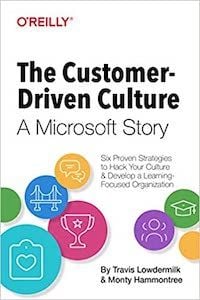 The Customer-Driven Culture by Travis Lowdermilk and Monty Hammontree;
The Customer-Driven Culture by Travis Lowdermilk and Monty Hammontree;
The Customer-Driven Playbook by Travis Lowdermilk and Jessica Rich
The Customer-Driven Culture explores that same thing. It’s the follow-up to The Customer-Driven Playbook, which I also enjoy a lot. Mark Hurst was a little ahead of the curve with this kind of thinking, but a lot of people are now realizing that it’s not enough to just hand off a report and say, “Hey, this is what our customers want.” You have to get stakeholders in the room, experiencing the customer research as directly as possible.
Playbook is great for looking at tactical approaches and exercises that teams can do together to put that kind of customer-centricity in the practice. And Culture is great for looking at ways to fold those practices and approaches into the way the teams operate day-to-day. These three together are my collective favorite in terms of thinking through customer-centricity.
The authors of all three books take a broad view, saying that customer-centricity isn’t just about getting things to people faster and cheaper. When you really understand the full complexity of human emotion and cognition, being truly customer-centric is much more complex than that. You can’t say, “We’re customer-centric, and it turns out our customers want exactly the things that drive profits for our business!” That’s not how it works in the real world. [These authors] are pushing for a different approach, one that truly challenges companies to question some of their own assumptions and orthodoxies.
RICHARD BANFIELD
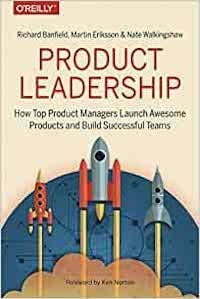 Product Leadership: How Top Product Managers Launch Awesome Products and Build Successful Teams by Martin Eriksson, Nate Walkingshaw, and Richard Banfield
Product Leadership: How Top Product Managers Launch Awesome Products and Build Successful Teams by Martin Eriksson, Nate Walkingshaw, and Richard Banfield
My co-authors and I had similar questions [about product leadership] that had not previously been particularly well-answered. Our biggest takeaway was, so many questions we had were also the questions that everybody else had. There’s sometimes a reluctance to expose one’s own inadequacies, so people don’t ask those questions. But in reality, we were all dealing with them and we didn’t have good answers.
So we could have honest and sometimes-vulnerable interviews. They could say, “I don’t really have good answers to this, but here’s something we should think about,” and give a perspective that helps us understand the situation better and helps readers start to explore opportunities.
And that’s really the goal in product, right? You want to be in a learning state, in an open mindset where you don’t have a solution in mind, but rather you question. And your job is to come up with really good questions, then deliver those questions in a way that ultimately provides objective answers. That was the big, lovely insight that we had.
But there were tactical things too. For instance, product leadership is not the same as management. You can be a competent, good manager, but that doesn’t mean you’re a good leader, and vice versa. You could be a leader, leading the conversation in terms of domain expertise or influence, but you may not be a very good manager.
Finding out how leaders made the transition from manager to leader — that was a very interesting conversation. Different people approached it differently, but came to the same place — leading through compassion, empathy and understanding with humanity.
Another thing that struck us was, there wasn’t really a strong theme of what makes a great leader. There wasn’t a solid set of characteristics that we could [point to and] say, “Oh, you absolutely have to have this kind of genetic or experience background in order to get to this particular place.”
Rather, it was mostly a combination of learning mindsets — the ability to put aside your own ego and current knowledge and be open to learning, be coachable and also [have] relentless self-development.
 Super Thinking: The Big Book of Mental Models by Gabriel Weinberg and Lauren McCann
Super Thinking: The Big Book of Mental Models by Gabriel Weinberg and Lauren McCann
I tend to lean into books that help me understand how to think. For the most part, we’re not as focused as we should be on understanding why problems exist, getting down to first principles. I really like books that take me to the place where I can universally apply the mental model approach. Technologies change, whereas mental modeling and understanding how people think is much more interesting.
The co-author, Weinberg, founded DuckDuckGo. The impetus behind the book was to collect the various mental models so that his kids could have access to them. Then he realized, Wow, this is something everybody should have. It’s really well-presented and accessible. People of all ages can grok it immediately. I find myself going back to it over and over again and asking myself, What are the ways to think, and how should we think, versus something that’s tactical.
 The ONE Thing by Gary W. Keller and Jay Papasan
The ONE Thing by Gary W. Keller and Jay Papasan
We did a survey years ago of what product managers suffer from the most; it turned out to be prioritization. The ONE Thing — the co-author of which founded Keller Williams, which is now the biggest real estate company in the world — is all about building a framework for prioritization.
It works really well for personal prioritization of time, energy and effort, but it works exceptionally well in the bigger context as well. If you think about roadmapping for product, one trap we fall into is, Here are all the things we want to build; let’s put them in a timeline. That’s horribly flawed.
But The ONE Thing asks this main question: What is the one thing we can do today that will make everything else easier, or even unnecessary? That idea puts a roadmap into a completely different context. You start thinking about what’s the one thing that will influence everything else, and that becomes your focal point. And then everything after that is allowed to be in a much more fuzzy state. You don’t have to overthink it or clarify too much, because once the one thing is done, then the next one thing reveals itself.
John Cutler, a product manager at Amplitude and popular management writer, talks about doing things in smaller batches. That idea fits nicely with the “one thing” concept — doing one thing, then connecting that. And those “one things” are questions. What’s the thing that I can do today that really helps? Then let it go from there.
 Play Bigger: How Pirates, Dreamers, and Innovators Create and Dominate Markets by Al Ramadan, Dave Peterson, Christopher Lochhead and Kevin Maney
Play Bigger: How Pirates, Dreamers, and Innovators Create and Dominate Markets by Al Ramadan, Dave Peterson, Christopher Lochhead and Kevin Maney
This book made me think about playing in categories in terms of where your product might fit best. It’s a bigger-picture viewpoint on product-market fit. It talks about this idea that a product-market’s fit isn’t even enough; you really have to think about product-market-sales fit.
I’ve heard that connection made in a couple of other conversations as well. The idea that you can own a category by creating a category is very interesting. In my current role, at InVision, we’re both a category creator and also dealing with the fact that there are other, new entrants into this category. And we’re trying to figure out what that category looks like over this tumultuous time.
And what we’ve recognized is, Play Bigger has some really interesting insights into owning categorization. So if you create the category, name it and participate in it, you’ve got a much better chance of winning than if you play in somebody else’s category, or you’re a pretender to that throne. That’s been an interesting perspective from an executive point of view.
 Good to Great: Why Some Companies Make the Leap ... and Others Don’t by Jim Collins
Good to Great: Why Some Companies Make the Leap ... and Others Don’t by Jim Collins
I’m a big fan of the flywheel-hedgehog concept outlined here. I use that very deliberately and intentionally with my team, with the whole company and with our go-to-market group. We like the idea of building momentum, and flywheels tend to fit very nicely into that. I’m a big fan of the classics and often reread those types of books that have stood the test of time. Measure What Matters by John Doerr is another favorite. I’m a big fan of OKRs and dig into that stuff from time to time.




